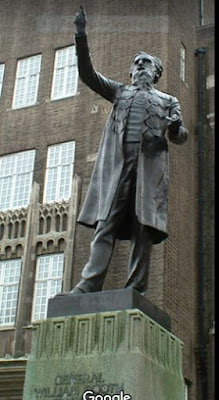Abney Park is located at Stoke Newington in the borough of Hackney in north London.
There are no spectacular gravestones or mausoleum, as the cemetery's founders were purists and rejected the extravagance of some Victorian memorials. The monuments are relatively simple and there is only one mausoleum. even the chapel and catacombs are plain. Even so, some of the memorials are protected and listed for their architectural and historic interest.
However for me, it is the most attractive of the five I have visited, in terms of environment. It is a woodland memorial park and Local Nature Reserve set in a large wood. The cemetery was laid out as an arboretum with a collection of more than 2,500 trees and shrubs and a "rosarium".
The first burial was in 1840. The cemetery fell into disrepair and was abandoned in the 1970s and became "wild". The London Borough of Hackney took over ownership of the site in the 80s, and today the whole area is well looked after.
The site of Abney Park was formed from the estates of Fleetwood House and Abney House, the latter of which had been the home of renowned non-conformist and hymn writer Isaac Watts. This association quickly made Abney the foremost burial ground for Dissenters – those practising their religion outside the established church. It was founded on these principles.
I went in the smaller south entrance. The main east High St gates are of Egyptian Revival style and feature hieroglyphics which read "The gates of the abode of the mortal part of man".
I hadn't heard of anyone who is buried here except for William and Catherine Booth, founders of The Salvation Army. Their grave is close to the south entrance. William died in 1912.
Incidentally there are statues of both of them in Whitechapel, as the Salvation Army was founded on Whitechapel Road.
And another outside William Booth College at Denmark Hall, by King's College Hospital (Google image) -
Close to their grave is the only mausoleum in the cemetery, it houses the remains of Dr Nathaniel Rogers, a wealthy doctor.
I loved the amount of vegetation and the fact that all the paths are well maintained, even the small ones. And there are many paths throughout the cemetery. There were also a lot of benches and everyone was occupied. It is obviously a popular place for locals to walk, exercise and drink coffee.
There are also lots of plaques with info about the historic trees. Some of the trees have now died but their location is noted, such as this dead Bhutan Pine planted in 1840 -
This is a large, recently restored memorial to Isaac Watts, the hymn writer who had lived in Abney house. However he was buried in Bunhill Fields (which I visited in 2016).
This tomb caught my eye as it is one of the more ornate ones -
War memorial built in 1920s and has the names of those fallen from both the First and Second World Wars.
The chapel is of simple design with no features that might imply favouritism for one or other of the Christian sects that would use it. It was intended as a funerary chapel and not a place of worship. It was also non-denominational, as the cemetery was established to be open to all, regardless of religious belief. The floor plan is in the shape of a cross and the arms of the cross are of equal length. It is the oldest surviving non-denominational chapel in Europe and is Grade II listed. The main entrance was covered for access by horse-drawn funeral carriages. The octagonal steeple is 120 feet (36.5 m) and was the tallest in the district when built in 1840. There is a 10-part rose window which fits with the horticultural role in the cemetery layout. The exterior is brickwork with facings of Bath stone.
A grand horse chestnut tree, with it's own carved sign -
I think these marks were made by a creeper rather than someone carving a design -
Many of the gravestones had these partly covered urns on top. Urns symbolise a vessel for the soul and the draped cloth indicates the thin veil between life and death.
This one is rather different -
This white marble lion commemorates the Bostock family. Frank Bostock travelled the world with a menagerie of animals and was a renown big cat tamer.
The next Magnificent Seven cemetery I visited was Highgate West and this also has a family grave with a lion, belonging to Geroge Wombwell, another travelling animal show.
I then went on a hunt for Joanna Vassa's grave. She was the daughter of Olaudah Equiano alias Gustavus Vassa, a black man who was shipped to England as a slave, served in the navy and obtained his freedom in 1766. He became a writer, Methodist and anti-slavery campaigner, and wrote a groundbreaking autobiography. I thought this was topical due to the recent publicity of the Black Lives Matter movement. Joanna was one of two daughters and her grave was only found in 2005 and is now listed by English Heritage.
These graves also caught my eye, the first for its intricate design and the second for the red granite pedestal and iron railings -
The Abney Park official website has lots of information about the history, heritage, people and biodiversity.



























No comments:
Post a Comment